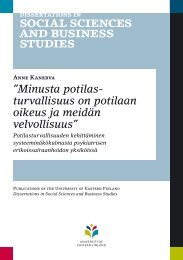urn_isbn_978-952-61-1770-6
urn_isbn_978-952-61-1770-6
urn_isbn_978-952-61-1770-6
- No tags were found...
You also want an ePaper? Increase the reach of your titles
YUMPU automatically turns print PDFs into web optimized ePapers that Google loves.
epeatedly. This repetition is called data saturation, and means that there comes apoint where no new information or themes are observed in the data. 53The position and effects of the Convention in the legal systems of the variousmember states of the Council of Europe is a matter of constitutional law. Thisstudy may be viewed from a public international law point of view because theECtHR is first and foremost an international court. 54 Therefore, interpretation ofthe Convention follows the general rules of treaty interpretation. Above all, thisstudy inevitably belongs to the field of human rights research. It may also beviewed as belonging to the field of European law if that term is taken to meannot only the law of the European Union (EU) but also the legal system of theCouncil of Europe. The point of view adopted in the research has been rathercritical when taking the legitimacy concerns as to the ECtHR as a starting-point.The study might also be described as European human rights law research.The interpretative methods used by the ECtHR have been the subject of muchresearch, 55 as have cultural, political and historical issues in which it is involved. 56The ECtHR has been the subject of critical studies, 57 and its doctrines are alsowidely studied. 58 Several recently published edited contributions have focusedon its interpretative limits. 59 Furthermore, the substance of Convention provisionshas been widely researched. 60 However, no research has been done regardingthe ECtHR’s argumentation and legitimacy.This study consists of two main chapters. Following the introduction, the secondpart (chapter 2) begins by summarising the ECtHR’s main methods of interpretationand patterns of argumentation. The point of this is to show the fieldthat has been focused on in each article, which is the practice followed by theECtHR in interpreting the Convention and the creativity it has shown in so doing.This also demonstrates why legitimacy is an increasingly relevant issue forthe ECtHR. Furthermore, the pattern of argumentation used by the ECtHR illustratesits culture and traditions in terms of giving reasons. The chapter continuesby outlining the current conception of judicial legitimacy. This is firstly done ingeneral terms but the chapter concludes with a discussion of two key aspects oflegitimacy, namely formal legitimacy and substance legitimacy, by reference tothe ECtHR. <strong>61</strong>53On data saturation, see e.g. Richards 2009, at 144–145. On the credibility of qualitative research, seee.g. Gobo 2007.54See e.g. Sicilianos 2012.55See e.g. Letsas 2009; van Dijk – van Hoof 1998.56Arold 2007; Christoffersen – Madsen 2011; Bates 2010.57See e.g. Greer 2006; Buyse – Hamilton 2011.58See e.g. Christoffersen 2009; Lautenbach 2013; Viljanen 2003; Mowbray 2004; Xenos 2012; Arai-Takahashi 2001; Yourow 1996.59Brems – Gerards 2013; Flogaitis – Zwart – Fraser 2013; Brems 2008; Føllesdal – Peters – Ulfstein 2013.60Leach 2014; White – Ovey 2010; Loucaides 2007; Janis – Kay – Bradley 2008; Reid 2011.<strong>61</strong>There are some inconsistencies within the articles as regards this concept. In the ‘social rights’ article‘substantive legitimacy’ is mentioned instead of ‘substance legitimacy’. In the ‘fourth instance’ article‘substance legitimacy’ is used. The inconsistency is a result of different opinions of the appropriateconcept by the jo<strong>urn</strong>al’s language editors. The content of the concept is, however, the same.23




